Charleston, SC and it is close to 80 today and we have flies again.
Gooey eye thing gone last night and still clear this AM. Was that worm die off or just dirt?
Gonna try to get him some relief with antihistamines and demand a skin scrape.
Thanks!

Charleston, SC and it is close to 80 today and we have flies again.
Gooey eye thing gone last night and still clear this AM. Was that worm die off or just dirt?
Gonna try to get him some relief with antihistamines and demand a skin scrape.
Thanks!
HBF - your old guy might be a really good candidate for flax. Don’t remember… what are you using as a fat source? Feel free to take this to email if it’s easier 
At what time of the year would you double the Equimax if you had a horse afflicted with Sweet Itch problems? (Horse in question came to me as a weanling from a BNBreeder, but FULL of round worms.) Several years later, someone thought she had microfiliae, with little lumps on her neck. (Her breeder had a huge dairy, btw.)
Would you dose just prior to the midge season? Now?
Thanks.
just bumping that last question as my guy developed a very itchy neck last summer with a couple of suspect areas…maybe sarcoid, but it’s gone now. I just gave him Equimax yesterday and am wondering about the timing of the DDEP program.
I think that part of the timing is based on geography/ weather.
I would imagine that south of the Mason-Dixon line (so to speak), anytime is good.
Maybe someone recalls from all the info linked, if onchocerca has a cycle based on length of day or warmth or anything like that.
I, hopefully, will have some evenings free in the upcoming weeks so I can compile the data into something comprehensive.
I’m gonna tease you folks :D… A nice lady wrote to me about 5 weeks ago about her filly. She was SEVERELY contracted and club-footed. She was on the verge of putting this girl down but, somehow, heard about me and asked if I could help. I immediately referred her to this thread AND my farrier/trimmer.
Well that lady sent me updated pictures about an hour ago and THEY ARE AMAZING!!! :eek:…in a very, very good way  I am waiting to get permission from her to post the pictures, as well as hear from Little D to get the story behind the pics.
I am waiting to get permission from her to post the pictures, as well as hear from Little D to get the story behind the pics.
[QUOTE=SSFLandon;3689214]
You have asked a question I also wonder about. Some say that the DD is just a few times but, when do you stop and consider something else the problem? Constantly deworming does have side effects…
for those that have found good results that’s great…I’m just curious from the experts on this thread who you suggest if your DD several times fails??[/QUOTE]
the most scary sde effect is that the worms are adapting … and every person that over worms (ie continous DDing and worming every 6 weeks etc) adds to the problem. soon ivermectin wont be effective anymore and it is one of the only wormers that is affective to a wide range of worms and there is no replacement on the horizon.
try doing a search on ivermetin resiistence - i think it is like 60% as effective as it was 20 years ago when it was introduced… you may just change the way you worm.
Please explain exactly how by killing them, you create resistance?
It is the UNDER deworming that people do that creates resistance.
Not to mention, people who only use daily dewormer and the twice a year ivermectin… aieeeeee… think of all the worms those horses never get dewormed for… OneLaneRode, where are you with your latest gathering on that? :winkgrin:
Horses have gotten bigger and the tubes haven’t.
by overusing a drug teh entities you are trying to irradicate becme resistent… ie: they evolve so that they arent as affected…
all you have to do is do a google search
http://www.pasturecleaner.com/pasturecleaner/info/parasitecontrol.htm
"Equine nematode parasites have reached alarming levels of anthelmintic resistance world-wide. There is substantial evidence documenting resistance across multiple continents to all anthelmintic drugs on the equine market. "
http://www.equinescienceupdate.co.uk/parascres.htm
"Further evidence of parasitic worms becoming resistant to ivermectin and moxidectin has been found. "
http://www.horseadvice.com/horse/messages/5/212790.html
http://www.thehorse.com/viewarticle.aspx?id=11668
etc etc etc
this is all due to OVERUSE of ivermectin. people worm too much. if you worm using the more modern method of fecal egg counts and timing you keep resistnece to a minumum and keep your horses healthy
Fecal eggs counts do NOT detect many parasites. FECs do not detect the parasite that this entire thread addresses which are the microfilarae from onchocerca. FEC do not detect encysted stages of some parasites nor any parasite that is not currently shedding eggs. Parasites exist in many different forms - eggs, larvae, juvenile, mature, encysted, etc.
FEC do not detect bot eggs which live in the stomach. FEC do not detect tapeworms.
Overuse does not lead to resistance - MIS-use leads to resistance. Underdosing and not following the proper timeframe between dosing. Listen to the radio and tv when they talk about antibiotic resistance in people. It’s because people do not take the entire dose they should be taking. They stop after 5 or 6 days instead of taking it for the full 10 - 14 days. aka underdosing.
The 60% resistance was found on BREEDING farms amongst weanlings. Situations where there is continually a high parasite load to begin with until young horses build up resistance to certain types of parasites. Not in the general populace. And, if I recall, those farms used 8 week ivermectin rotation and no other class of anthelminic?
From this link: http://www.pasturecleaner.com/pasturecleaner/info/parasitecontrol.htm
In northern temperate climates, refugia are smallest during the winter, where development of free-living stages occurs at a very low rate. In contrast, refugia are smallest during summer in warm temperate and subtropical/tropical climates, where hot temperatures decreases survival of third stage infective larvae.
This discussion also references some studies on resistance for some parasites. I would not have called it conclusive though. This discussion uses the term refugia as being the small minority of parasite stages that have survived a treatment. It recommends backing off on anthelmintics during those periods of time.
This is exactly why rotations specific to regions are necessary and why it is always recommended that people discuss and formulate a rotation with their equine vet.
Which is why here in the north, I schedule 8 weeks between treatments in the winter months and 6 weeks in the summer - which coincides with my farrier appointments. : )
yes, of course incorrectly using something is a problem - but more importantly is the problem of people using drugs inappropriately - and creating a huge resistance problem.
if wormer’s are used correctly (ie by using fecal egg counts and timing the worming to when it will be effective (eggs hatching, shedding etc etc etc)
then you get the most bang for your buck and you use as little as possible to get the results you want - this helps keep residence at bay.
exactly the same as antibiotics for people.
the worming schedules recommended by vet schools, the AAEP etc is based on fecal egg counts and correct timing. the every 6 week schedule is old school and was based on marketing.
and this double dose fad is really scary as all it will do is increase resistance.
In regards to your second “reference” …
Parascaris equorum, the large roundworm of horses, is a common parasite of foals. Older foals develop immunity to it, and it rarely causes problems in adult horses. Under optimum conditions, P. equorum eggs become infective within about two weeks of being passed in the faeces. At lower temperatures the eggs may survive for many years in stables and on pasture.
and
In a report in Veterinary Parasitology, Professor Owen Slocombe of the Ontario Veterinary College, and others describe how they found ivermectin- and moxidectin -resistant P. equorum on stud farms in Canada.
So. they found ivermectin/moxidectin resistance to one parasite and it is one that is most perilous to foals. However, the study says this:
Overall, they found that ivermectin reduced the Parascaris equorum faecal worm egg count by only 33.0% and moxidectin by 47.2%. In contrast, fenbendazole and pyrantel pamoate were highly effective, reducing the faecal egg count by 97.6%. In fact, many foals had no P. equorum eggs in the faeces after treatment with fenbendazole or pyrantel.
and it’s summary is this:
This study emphasises that a single dewormer cannot be assumed to control all species of worms in foals. It may well be necessary to use more than one type of dewormer to control all the potential parasite problems in foals.
So. resistance exists and rotating is the answer. NOT stopping regular deworming treatments. When the parasites developed resistance to non-ivermectin treatments, then ivermectin was used. When there was resistance to ivermectin, they switched back to the other classes. No where does it say that too many/ too frequent doses cause resistance.
This study supports the idea of yearly rotation amongst classes. Use ivermectin/moxidectin for a year, then switch to the -dazoles.
“Parasiticidal Resistance Reported in New Study
June 19 2008, Article # 12105
Kentucky researchers report that roundworms and small strongyles, two common equine intestinal parasites, are developing resistance against most of the commercially available worming products. What’s worse, no new drugs against either of these parasites are forthcoming on the market.”
https://www.thehorse.com/ViewArticle.aspx?ID=12105
i am not going to do dueling links with you.  but my reading has led me to change how i worm and has caused me to be worried about the future of worming… . <shrug>
but my reading has led me to change how i worm and has caused me to be worried about the future of worming… . <shrug>
mbm - have you read how the 5-day power paks work?
They knock out a very large percentage of parasites the first dose, then the 2nd day, they get another percentage; on the 3rd day, it takes out nearly all the parasites that that class of dewormer targets. the 4th day picks up some more stragglers. The 5th day is a “just in case” dose.
It won’t get all the targeted parasites. But it takes at least 3 days of DOUBLE DOSE to clean out the horse of the targeted parasites.
The same is true for the DD Equimax or DD Ivermectin against THIS (microfilarae from onchocerca) specific type of parasite. No one is advocating everyone should do this - only to target the specific parasite and the condition - whether it’s the summer itches / midline itchies or the contracted tendons.
It’s like taking steroids. My doctor doesn’t want me on them all the time - but there ARE instances when I - and other people - have to take them. I start out with a large dose (6 pills) and it tapers down to 1 pill over a week. It’s for a specific problem and hopefully, it lasts a year or two before the condition returns.
I hope this analogy helps some folks to understand.
i didnt say there was anything inherently wrong about double dosing (with vet approval) - however, my point is - the fad of double dosing for any old suspected reason is one thing that is helping spread resistance to ivermectin - just like people taking (or giving) antibiotics for any old reason is helping reduce the effectiveness of antibiotics.
it is just common sense.
Out of curiosity, what would be the current, COTH-approved worming program, comprehensive to include hoof worms?  No, kidding on the hoof worms, but I am curious.
No, kidding on the hoof worms, but I am curious.
AMAZING CONTRACTED FOAL CASE STUDY
Ok, got permission and the whole story from the owner:
Annie’s feet were obviously ‘going bad’ at around 2 months. By 3 my regular farrier said, “You need to find someone that can help you with this – it is out of my league.”
I talked to several different farriers and vets and did everything they said (except surgery) – the early weaning at 4 months, reduced quality of feed, special trims, special cuffs… and her feet continued to get worse.
I am on the Carriage Driving List and happened to have a sleepless night one night and followed a thread someone posted about threadworms and itchy skin. Eventually it ended up at the C of the H site, and there was a reference to club feet. I followed that line… and found you!
November 10 I double dosed Annie with Equimax for the first time. (she was the single itchiest baby we had ever seen! She would turn inside out for a good scratching. She never had any sores, before or after the E-Max.) She continued to get worse.
Then found you and DJ, double dosed again and 2 weeks later was able to have DJ come here (and meet with my regular farrier and my back-up guy) work on Annie and explain what she did, how and why. (By then, with 2 double doses of E-Max at work, her lower legs were already gaining in flexibility.)
Annie was immediately more comfortable, and within 3 days, except for those awkward, heavy casts, walked ‘normally’ – that is, her strides were normal, legs back under her shoulders instead of stretched out in front, she was no longer using her back and hocks to stay up, and the tendons, etc at the fronts of her front legs relaxed. Her shoulders softened, as did her knotted up back muscles.
I diligently filed her heels every day or 2 and walked her 2x daily, then 3, increasing amts, up and down hills, and finally turned her loose in the barn all day every day. (Fields too wet and hilly to safely put her out with casts on her feet.) After 3 ½ weeks, one of the cast/shoes started sounding loose (like loose shoes do when they are going to be really loose in a day or 2).
The plan was for DJ to come back (or my regular farriers to work on her, depending on schedules, etc) in 4 weeks, remove everything and reevaluate. With it being loose and potentially making a sore somewhere, DJ (was able to work her schedule around to come…a 3 Hour drive for her) took off the shoe/casts and I took more pictures.
I could tell before that, that they were definitely improving. Annie was ‘going to her heel’ every time I filed and I was taking as much as I could as fast as I could without her getting sore.
But when those casts came off and she went clear to her heel on the floor I almost cried. 3 ½ weeks!
We obviously aren’t ‘there’ yet, but looking at those pictures it sure looks possible, doesn’t it? She is 7 months old now, a grand little filly, very sensible and quick as a wink. If all continues on as she is now, in a couple months she will be able to go out and play in the pastures again while she grows into a sound and safe performance horse.
The before and after pictures tell it all.
–Jenny Bennett
The first picture is the BEFORE…the rest are after Jenny’s and D.J.'s care.  PICTURE 3 shows the cast still on the other toe/hoof.
PICTURE 3 shows the cast still on the other toe/hoof.
NOTE: While this filly responded well, it is because Ms. Bennett did her "Home"work and followed instructions to the “T”…keeping up on the deworming, rasping those tiny heels AND making Annie exercise. Alas, D.J. has had clients with foals just as bad that didn’t do as well, simply because the owner wouldn’t do their part.
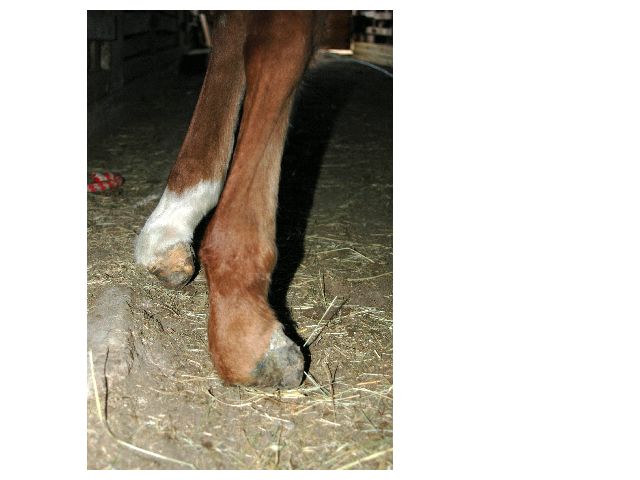
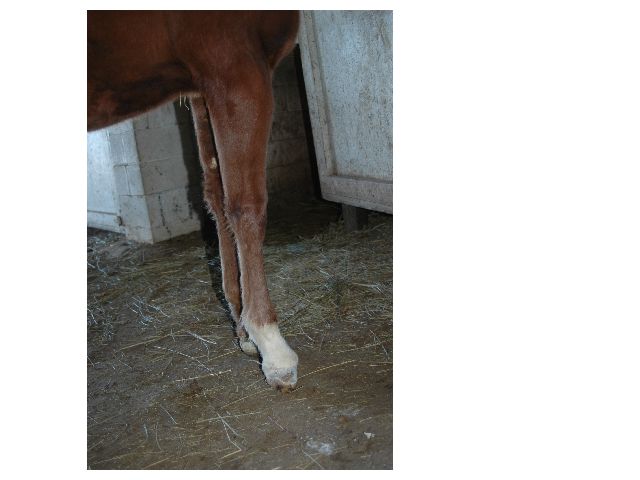
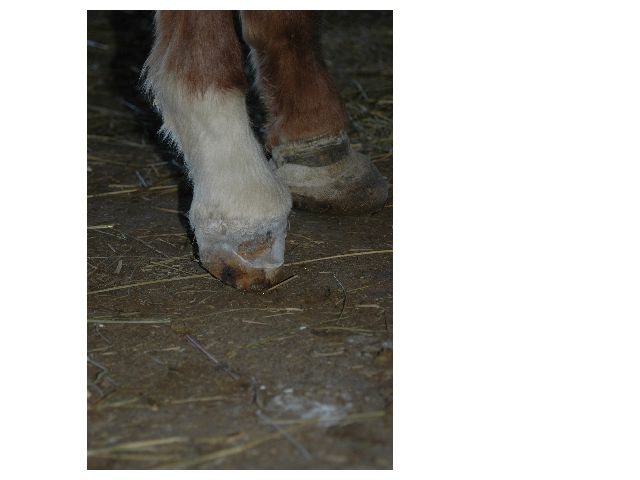
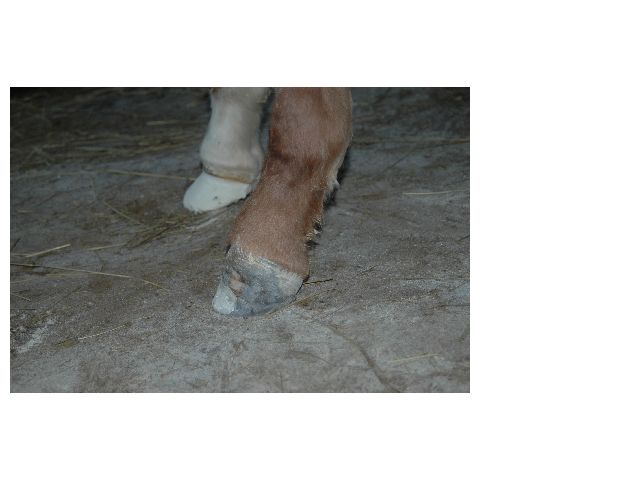
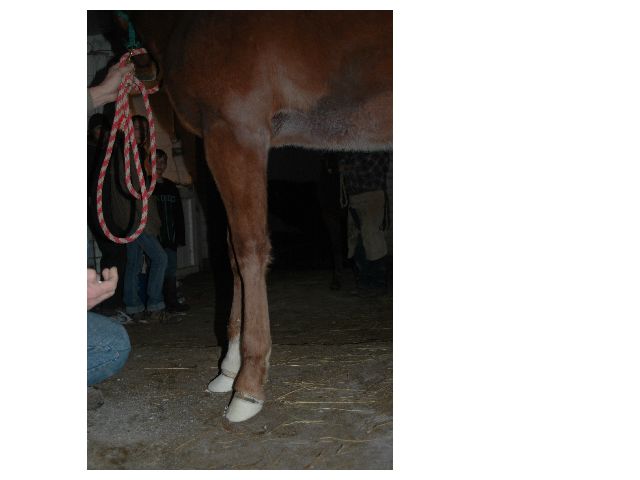
WOW !!! Just absolutely amazing!!! You Rock, LittleD.
thank you
thank you very much. for you applause. I know Im not here much have to appologize.but tull my computer gets fixed well Im mostly out of touch. GABZ my hat goes off to you. thank you so much for standing behind this treatment. Atleast those that do dd are trying to do something for their horses and when all the expensive vet treatments dont work. well you take things in your own hands to help the ones you love.